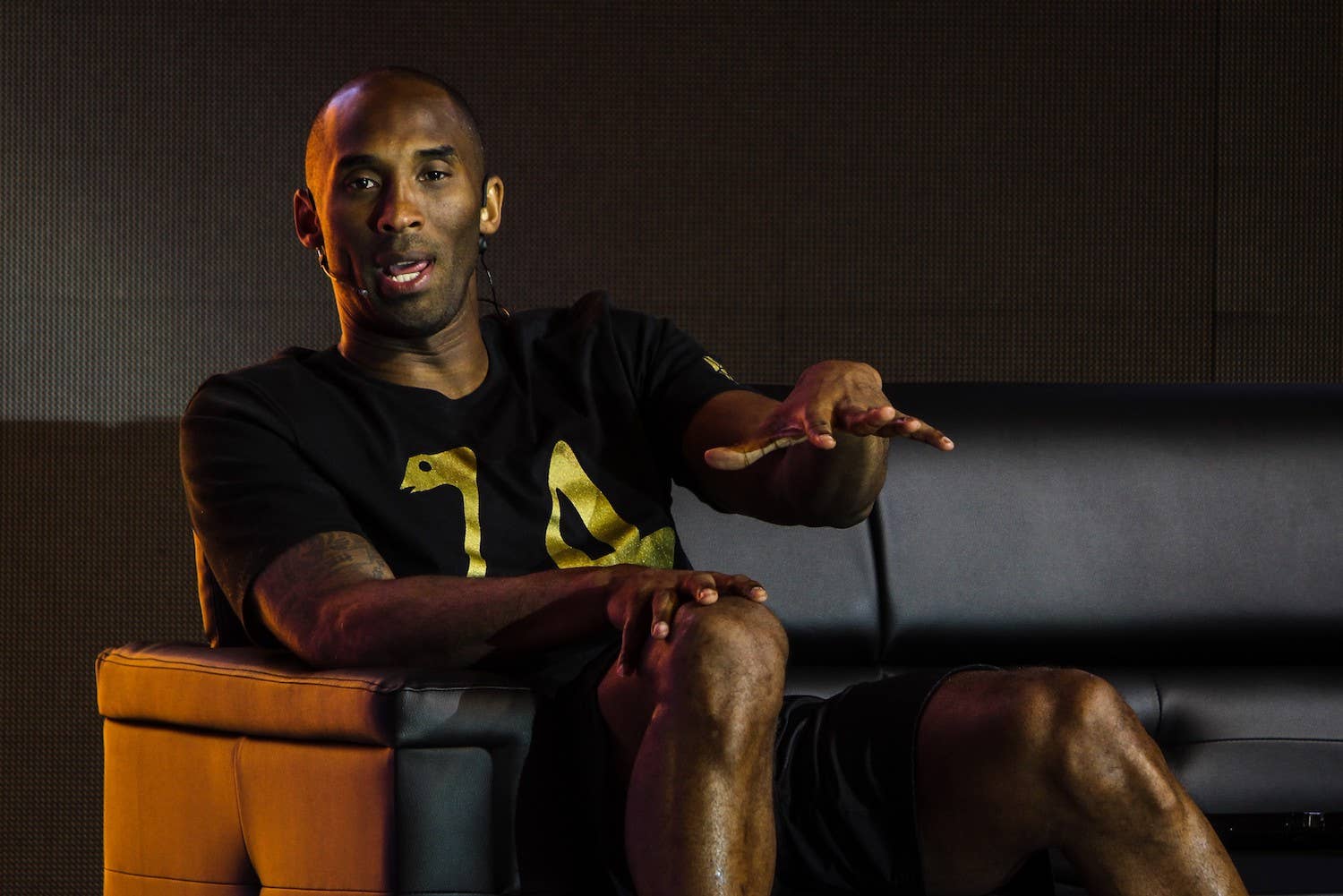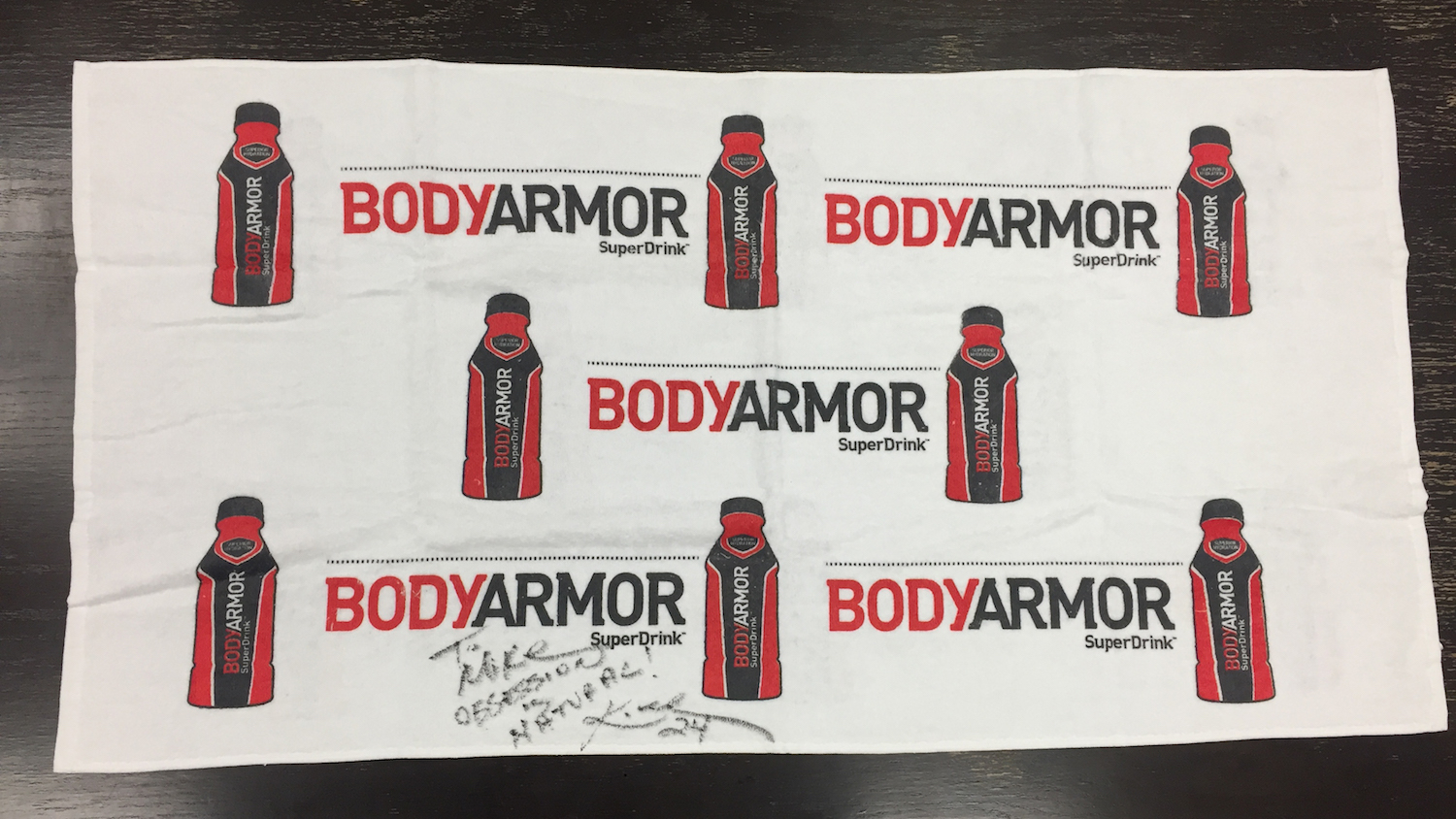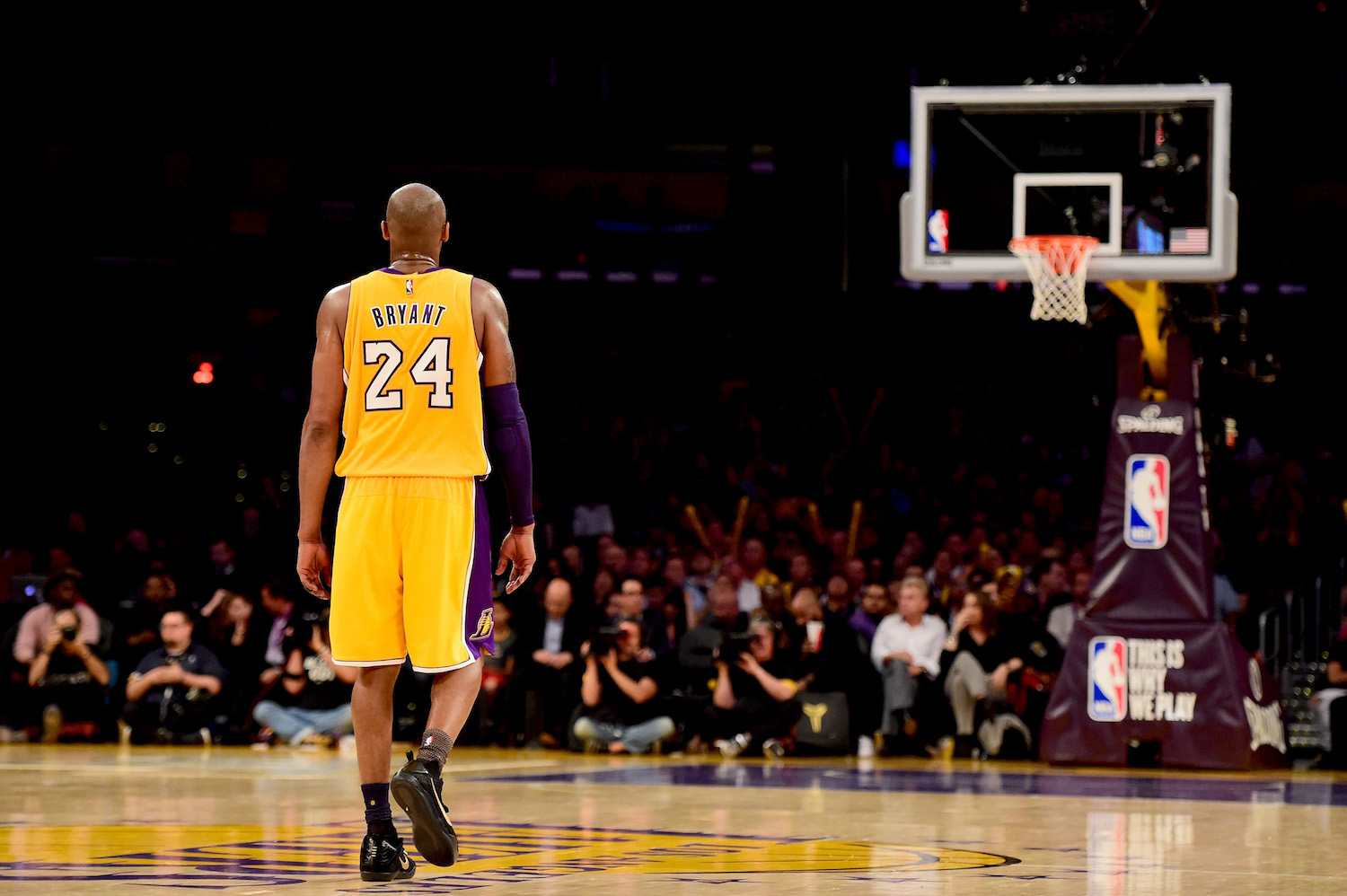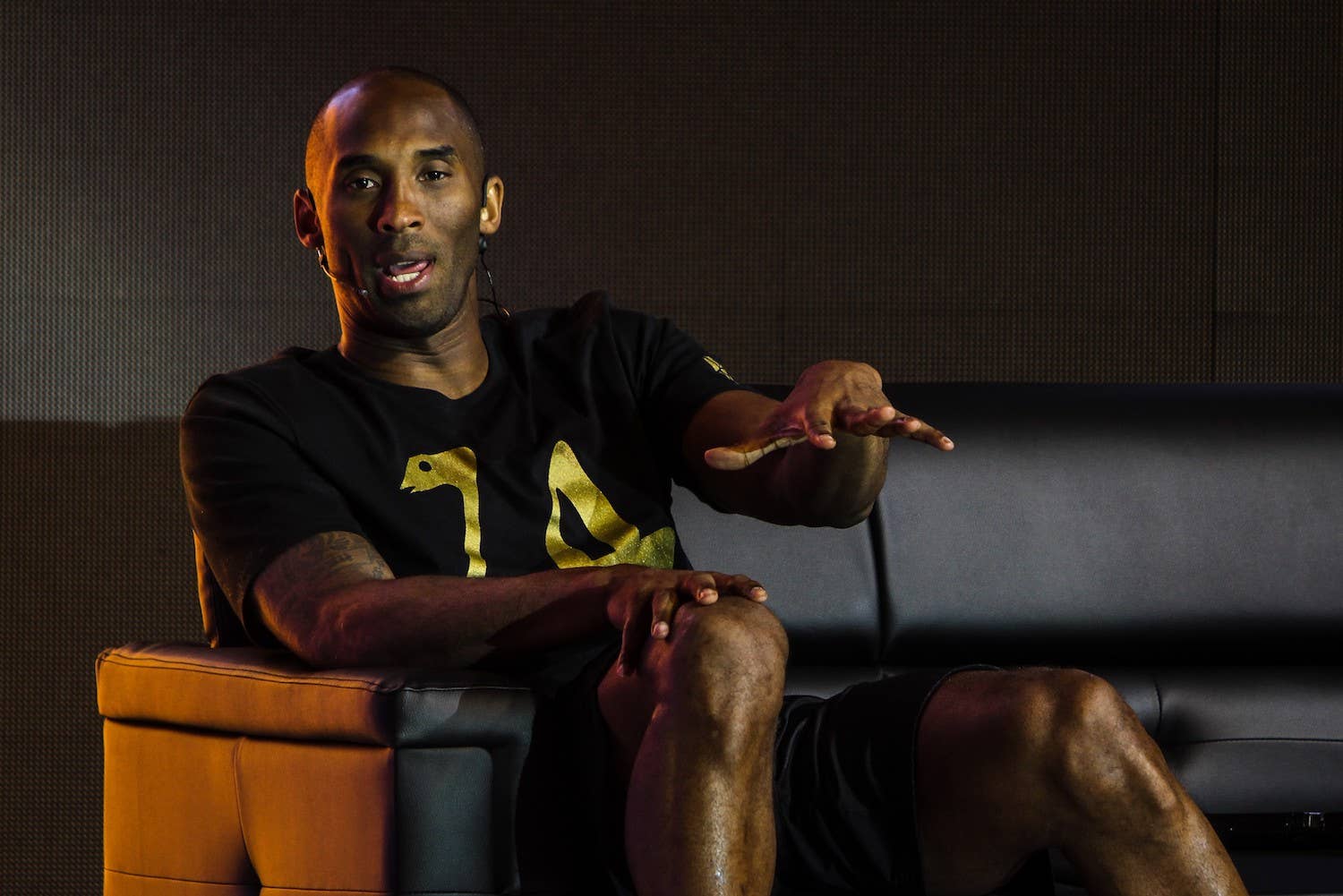
Kobe Bryant doesn’t miss basketball.
Just because he says it doesn’t make it true, to be sure. But the way he says it, with such conviction and downright wonder—like in a “I know it sounds crazy but seriously” kind of way—makes it seem believable. It’s entirely possible that the game that consumed him for much of his 38 years no longer holds the same power over him. But he has to be at least watching the playoffs, right?
“No, I didn’t get a chance to, man,” he says with a laugh from his California office. “I’ve been busy. It’s one of those times of the year where everything kind of comes in at once, so there’s a lot of things I need to get through; projects that need to be finished, the next Canvas piece, other things that I’m editing, the BodyArmor sports drink campaign and launch, and then the TriBeCa film festival. So there’s a lot hitting right now.”
Bryant’s all-consuming passion hasn’t changed, it’s just shifted focus—from basketball to storytelling. What was a secondary pursuit during his playing career as he plotted out sneaker designs and advertising concepts for Adidas and Nike has become his profession. And while he’ll dip back into hoops from time to time, taking calls from current players seeking advice and writing a Hall of Fame induction speech he’ll need in a few years, he doesn’t see himself re-joining the NBA officially in any capacity.
“No. No,” he says. “I love what I’m doing. I love story. We love what we love, man. I can’t get enough of this stuff.”
With the launch of “Obsession Is Natural,” the first video of his BodyArmor sports drink campaign—a spot he wrote, creative-directed and narrated—we talked to Bryant about his new job and passion, one that’s already made him not miss the old one.
[This interview has been edited and condensed]
I. BodyArmor, Obsession and Kobe’s new role
How does the way you prepare now differ from when you were a player? I know you were a meticulous guy right from the start.
Yeah, well it’s different because in sports, you have deadlines that you can’t push back, right? So if the game’s at 7:30, then the game’s at 7:30. Either you did your work or you didn’t, and if you go out there and you have an off night, you have an off night. There’s no receipts on our performances. You can just make people forget what they just saw. But with storytelling and writing, I can really sit and go over every word, every break, every look, every edit, every cut, every sound until it is absolutely perfect. Until I feel like it’s the best that we could possibly do. And that’s what’s beautiful about it—that this process is open. And also you don’t have to shut it off. With training, you have to shut it off at some point, physically. But with story and writing and creating, I don’t. My mind is always going, so it’s great for a personality like mine. For an obsessive person like me, it’s fantastic.
I feel like your definition of “perfect” is different than most people’s. Some people probably think, “Oh, this is good now.” And you’re like, “Nah, nah, nah. We gotta keep refining this.” Is that what it’s like?
Yeah, but you know truthfully, every person has a general idea of what perfection is. You know what I mean? Like you could look at something and say… not that perfection even exists, but the idea of, Is this the best that I can do? I think all people have that inner clock that understands if this is their best work or not. I just feel like sometimes we take the shorter route and say, “Yeah, this is all I got,” or when it comes to story, we kind of capitulate to what corporate governance wants to see as opposed to being true to the art and creating something that we feel is timeless. I have that stubbornness and I have the energy to stick with something and see it all the way through, and not compromise the art because the boss is still like, “We need something that’s very loud and that speaks to everyone now.”
"With storytelling and writing, I can really sit and go over every word, every break, every look, every edit, every cut, every sound until it is absolutely perfect."
Right. I mean, obsession is obviously a big part of this. Was that something you brought to the table? Was that your word at the start?
Yeah, it’s crazy. It’s a funny story how I wrote that line. One of the towels that I used in my last game, a BodyArmor towel, I signed it for [BodyArmor chairman] Mike [Repole]. So I signed it, “To Mike, my man.” You know normally you just put “best wishes” or something like that. I tried to come up with something to say to Mike that’s different. The first word I thought of was obsession because he and I, I mean, we both laugh about it. We say it’s both our gift and our curse because we’re both obsessive. And then I thought of the product, and then I thought of how obsession is natural to us. So I wrote, “Obsession is natural,” and I signed my name. Right after I wrote it, I looked at the towel and thought, “Oh, that’s it.” [Laughs.] “That’s our line.” And that’s how it came to be, just like that.

So the line came first. I mean, the line came as a totally different thing? It wasn’t even thought of in this context?
Well, nah. I mean, we knew what the personality of the brand was going to be. I was already in the back of my mind, thinking “What should our ethos be?” So that was kind of sitting there subconsciously for me already. And I had already kind of been looking and thinking, but then when this moment came it just came organically, which is the best way I think because it’s the truth of he and I who founded this thing. This is our finale, this is who our brand is because this is who we are. So it came out in that form, but truthfully it’s been in the back of my mind for quite some time. I just had to put the words to it.
Yeah. It’s funny—I watched that first spot today. You’re speaking those lines, and to me, as someone who’s watched your entire career, it sounds like an inner-monologue you would have.
Oh, for sure. [Laughs.] For sure. But the challenge for us in writing the spot was how you not simply hear what it is that I’m saying, but then how does the viewer internalize what I’m saying. Like they look at themselves and say, “Okay, am I that obsessive about what it is that I’m doing? Do I want to be?” Because that’s the challenge. That’s the challenge. The spot is a challenging spot. It’s saying to be an elite isn’t for everyone. It’s not for everyone. If you want to be that, then you’ve got to ask yourself two questions: “Am I doing that already?” and “Do I want to do that if I’m not?” Right? So that’s the challenge. Throwing down the gauntlet and challenging people, saying, “Listen man, if you want to get to that level, this is what needs to be done. And if you don’t want to do that, you might want to reconsider what your passion is.”
Is that how you considered this group or these guys who are the faces of the brand now as well?
Yeah. The athletes that we have all share that same philosophy. From Andrew Luck and his recovery process coming back from shoulder surgery, James [Harden] and what he did last year during the off-season. I mean he worked obsessively every single day to play the way that he’s been playing. And then you have Skylar [Diggins], and then you have young athletes like Kristaps [Porzingis] who’s at the inception, at the beginning of it. And so if I could write a line that not only challenged young athletes everywhere but also the stable of athletes we have internally, then we’re doing the right thing because we want to challenge and push them, as well. So if the message resonates with them, then I think we’re good where we are.
II. Nike, Patience, and Agency
Did your career allow you to have that sort of perception? Because you are Kobe Bryant the person, but obviously you understand how people view Kobe Bryant the athlete.
The most important thing that I’ve learned there is the patience that it takes to get there, right? The reason why we can do a Nike campaign and have our Nike teams wear UConn Mentality, Oregon Mentality, Duke Mentality, the reason we can do that is because over time, I’ve built, through messaging, what my mentality is. And what Mamba mentality is. It’s that patience. So with BodyArmor, what gives us the ability to be able to do this thing is from my understanding that patience is what wins at the end of the day. Obsession is natural. This is what we do, year after year after year. This is how we build this thing up, and having a message that resonates with our athletes and is something that they naturally do is extremely important because like James, he doesn’t have to do anything different. He doesn’t have to parade around and talk about BodyArmor all day long. There’s nothing worse than when an athlete is feeling forced to talk about a product that he’s not wearing on his body, you know what I’m saying? It becomes, okay well, how do you talk about it? How do you talk about BodyArmor? How do you talk about the health benefits it provides you? Well, let’s focus on your process. If you’re obsessive about your process, you’re also obsessive about what goes into your body. Alright, so let’s unpack that, and let’s go all the way through it. How are you training? How many reps are you doing, etc.? So something that’s natural for them.
Did working with Nike and doing stuff with them help prepare you for this? Just hearing the way you would talk about your shoe, that was all very consistent with your first career.
Well, yeah. Nike gave me the ability to do crazy s–t. So we both grew up on that Nike stuff, like the Jim Riswold spots, you know what I mean? So when I got to Nike, it was like, alright, I’m looking forward to carrying on that legacy and tradition. And what I found was everybody was playing the safe side, and I didn’t want to play the safe side. So then it became alright, Kobe’s not gonna settle for anything besides campaigns that he saw growing up so we better get to this thing. At points, I enjoyed working with all the talented people at Wieden, all the talented people at Nike, and vice versa because they knew that on our project, we were going to do something that hadn’t been done before. Or something that would strike a nerve or make you a little uncomfortable. And yeah, I certainly learned a ton from that process.
How is this different? 'Cause this was more coming from you, right? This was less of any sort of corporate directive, because you are the corporate directive.
Ah, nah. It’s the same thing. So with Nike it’s the same thing. You know, Phil Knight’s lesson, his mantra is the most important one to know, which is, “Listen to the voice of the athlete.” And I had something to say. So on all my spots with Nike, I was essentially creative director, just not in official title because I was the athlete. It’s the same thing. I’d sit down and say, “This is where I’m at this year, this is what I think the messaging should be.” The Black Mamba theme, the Mamba Mentality line, I wrote that on a plane trip from China. I wrote Mamba Mentality. So you know, it’s the same process, man.

Okay. What’s your schedule like now? As an NBA player, your schedule was pretty tightly regimented. Is that something you’ve carried over?
I mean, nah. I make my own schedule now beyond practices that I have to go to that are scheduled or games and things of that nature. So I can move things around. It’s a lot of writing, it’s a lot of editing, it’s a lot of listening, and it’s a lot of researching and looking for global inspiration. Understanding psychology and human nature. You know? Things of that sort. Because the magic is how you take a very sports-specific message and connect that to human nature as a whole. That’s really the magic sauce.
I have my office here, and we have our chief marketing officer president focused on business development, things of that nature. And then we have a cast of young producers and engineers and editors that help bring my vision to life. Like Canvas City, for example, I mean that whole thing was built by just our small team here making things by hand and cutting things ourselves. So our office is part corporate and part making s–t.
"It was like I was tipping my hat to the game, and game was tipping it’s hat back to me, and we’re just saying to each other, “Listen, it was a beautiful run. Now we go our separate ways."
Has this been fulfilling for you in the same way playing was?
Actually beyond. And that sounds scary to say, but there’s nothing more beautiful to me than to receive mail and messages from a mother [or] father who say they sat down [with their kids] after they watchedCanvas City. A father may have watched it by himself, and after he watched it, he immediately went to the bedroom and grabbed his daughter, grabbed his son and his wife, and said, “We have to sit down and watch this as a family.” There’s nothing more fulfilling than that because when I can put in very strong and heavy messages that kids at the age of 10, 11, 12 feel already, but as parents you have a hard time communicating to them how they should respond or deal with those feelings, if I can put that in content so that the kids can digest that information and understand what to do with it, then that is a greater feeling than anything I’ve ever experienced.
It’s funny, because I feel like when a lot of athlete’s careers end, they seem unsure of what that next step is. You seemed very sure of what that next step was. How long had this been in the works?
Since I was 21. I started an ad agency first. I’ve since sold the ad agency. It’s doing phenomenally well to this day. But I knew story was the area that I wanted to be in, and [so] when the Muse film came around –and with my injury and all this other stuff– I looked at the first cut of it and I wasn’t happy with it. I wasn’t involved in it at all. [But] at the same time, when I viewed the first cut, I realized [that] story is where I want to be. So then I was like, “Let me see if I can re-write this whole film,” and that’s what I did. I re-wrote the whole film. Jake Block, who was my partner here in building the studio, I told him this is what I’m looking for. This is how I want to write it, this is how I want it shot. I want to direct the camera, one voice, black shirt, shot cinematically, I want original music. And then he quickly assembled the team around to be able to do that. That was the tipping point for me, where I was like stories are where it’s at, whether it’s novels, fantasy, film, short form, long form. This is it for me because there’s no greater feeling.
The biggest problem athletes have is not being able to find what it is that they love to do, you know what I’m saying? So if I sat there and said, “Okay, when I retire, what is the biggest industry I can get into to make the most money?” That’s the wrong way to look at it. You have to start looking at it as, “Okay, what do I love to do?” And I started that at 21 because I knew my career would come to an end. I have to find something that I love to do just as much as I love playing basketball. And if I find that, it makes waking up in the morning great because I wake up with a sense of purpose, with a sense of excitement because I love what I’m doing. So the key is to find what the next love is gonna be.
What do you miss the most about playing?
I can’t sit here and tell you I miss one thing in particular because I haven’t thought about it.
You haven’t?
No, which is crazy. I haven’t. I haven’t thought about it. Like I genuinely haven’t. The piece that we were debuting at TriBeCa, Dear Basketball, when you see it, it really speaks to what I’m talking about. It was like I was tipping my hat to the game, and game was tipping it’s hat back to me, and we’re just saying to each other, “Listen, it was a beautiful run. Now we go our separate ways. But we both know, what I’m taking with me in this next industry, I’ve learned directly from you. ” So there are no regrets. There’s no hard feelings, there’s no anything. There’s “thank you” because I’m carrying those messages with me. So when you see “Obsession is natural,” that’s a lesson I’ve learned from the game. When you see Canvas City andMusecage, those are things that I’ve learned from the game. So the game is still with me.

III. Creative Mentors
You mentioned Jim Riswold. Who are some of the other people you look up to in terms of storytelling?
Dan Wieden. I’ve had great conversations with Dan. J.J. Abrams, Steven Spielberg, John Williams, Glen Keane, J.K. Rowling, George R.R. Martin, who else? Lawrence Kasdan. These are people that I reach out to and speak to and ask advice from. Yeah, I mean, it’s a great list of mentors to have.
What’s been the best piece of advice you’ve been given?
Dan Wieden said something that was really interesting to me. He said, “Most people look at demographics and psychographics and all these research papers and all this other s–t.” He said, “Dude, just speak. Speak simply, speak plainly, and speak powerfully. That’s it.” That is it. Everybody else is doing all this other stuff. The stuff that you remember is the stuff that’s really easy to remember and that carries a deeper significance that comes out naturally. His ability to boil things down to its essence is something that I’ll always remember. But yeah, Steven Spielberg gave great advice, J.J. Abrams gave fantastic advice about story and the journey of character development and growth. I’m just very f–ing lucky to have people like that in my corner, man. Jony Ive. Jony Ive has been absolutely terrific in being able to pick up the phone and talk to him. I’ve just been very, very lucky.
"My game was built piece by piece. That doesn’t all happen in one year. It happens incrementally. So I’m painting the same way, it’s just a different canvas."
Do you feel like messaging is even more important than the product? Or is it a kind of hand-in-hand thing?
It goes hand-in-hand. The product and the messaging must be one and the same, right? It’s like a triangle approach I take with all storytelling. You take the product for example, BodyArmor. What is the essence of the product? What is the product here to do? What is the messaging that we want to represent? How can we best communicate that plainly and simply? And thirdly, how do both of those things relate to human nature as a whole? If those three things align, then I know we have the right messaging.
What would you say the most difficult aspect of bringing this message to light has been?
It’s just patience, man. It’s just patience. We didn’t want to come out with a heavy message. All the messaging before was very educational in nature, very informative. Like the amount of vitamins we have, potassium, etc. All of that stuff is very informative until we got to a place where we thought our distribution was broad enough to then be able to start opening up and start doing more emotional messaging. Our distribution can support doing a TV spot, so really just having the patience to wait for the right time to be able to do this. And still remain consistent forever. So it’s building this messaging year after year.
Do you find that you have more patience in this than you ever did playing basketball?
No, it’s the same thing. Like my game was built piece by piece. It was built incrementally. You don’t overload. You don’t in one year all of the sudden develop an outside shot, a post game, handles, screen-and-roll coverage, great defensive coverage, be able to guard the screen-and-roll, be able to guard the post. That doesn’t all happen in one year. It happens incrementally. So I’m painting the same way, it’s just a different canvas.


